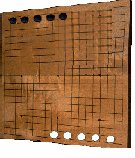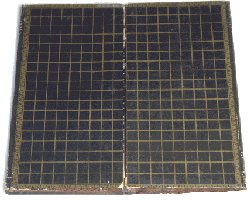
This is a game of indeterminate age, having been brought from China to Japan in the dim past. The game in China is played on the un-checkered lattice board used for Wei-K'i, and in Japan the game is played on a traditional Go board. The traditional Go board and counters are illustrated in the photograph on the left.

The game of Gomoku ("moku" - five stones) is played on the 18x18 lattice board as illustrated in the photograph on the right. (Players may decide to limit the game to a smaller lattice, e.g. - 9x9.)
Each player uses only five counters from the Go set. Unlike the game of Go which is played on the intersecting lines of the lattice, Gomoku is played on the cells of the lattice.

According to Whitehill, Parlett, and H.J.A. Murray, in 1885 the game appeared in England and a few years later in the United States under the name Go-Bang (a corruption of the Japanese "Go-Ban" - "five board".) The black Go-Bang board on the left was produced by The McLoughlin Brothers, New York City, sometime around 1887. Its design is close to the Japanese original, with gold lines making an 18x18 lattice.
The game was purchased by the Museum and added to the Collection in 1981. The board is 35.5cm long x 37cm wide x 2.5cm thick. When folded in half, the Go-Bang board forms the "outside" of what looks like two large books standing side by side. The "inside" features two other games - one called Tivoli - and the other is a version of the game of Fox and Geese. The game includes 38 natural wood counters (1.75cm in diameter x 1cm thick) each in the shape of a flattened hourglass. Eight counters are in their natural color, 7 are colored black, 9 are green, and 14 are purple. There were no instructions included with the game.

The game illustrated on the right is from the 1920s, and is a modification of the traditional Japanese game of Gomoku. This copy was donated to the Museum in 1990.
To make playing "easier", this manufacturer punched out the cells in the lattice, and pegs are used as counters. The picture of the board on the box top is somewhat deceiving, since the manufacturer has reduced the size of the board inside of the box to a 16x16 lattice, however, the game was adapted to enable four people to play.
Before Gomoku begins, players may decide how many cells of the lattice may be used for the game. For example, players may agree that only a five by five lattice (25 cells) will be used - or the entire 18x18 lattice may be used. To start, players place their counters opposite each other on the end rows of the size lattice they have decided on. (For the 1920's version of Five In A Row, players may agree that only a ten by ten lattice (100 cells) will be used - or the entire 16x16 lattice (256 cells) may be used. To start, players sit opposite each other on the four sides of the board. Each player places five pegs (of one color) on the end rows (nearest to each of them) of the size lattice they have decided on.
For Gomoku each player in turn moves one counter one space to the next empty cell either horizontally, vertically, or diagonally. (For Five In A Row, each player in turn moves one peg one space to the next empty cell either horizontally, vertically, or diagonally.) The game continues as each player attempts to get three pieces in a vertical or horizontal row only - the starting row does not count, and jumping is not permitted. If a row is made, a player may remove one of the opponent's counters from the board. Captured counters can not be used again in that game. A player left with only two counters is the loser.
Last update March 30, 2010